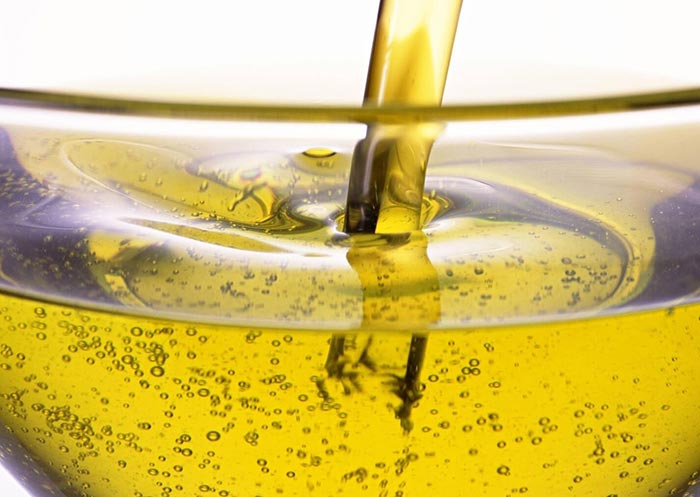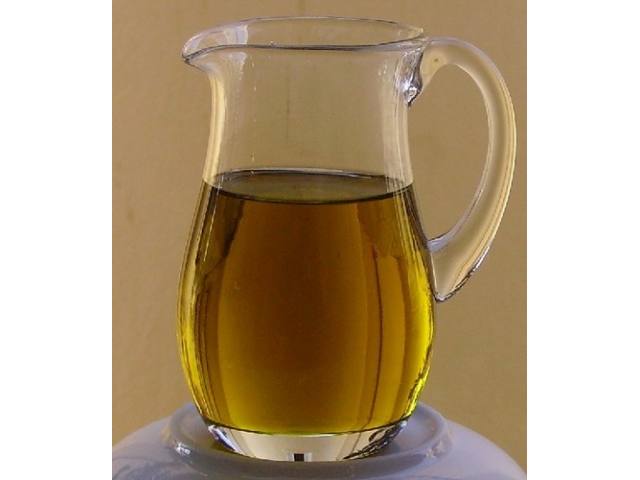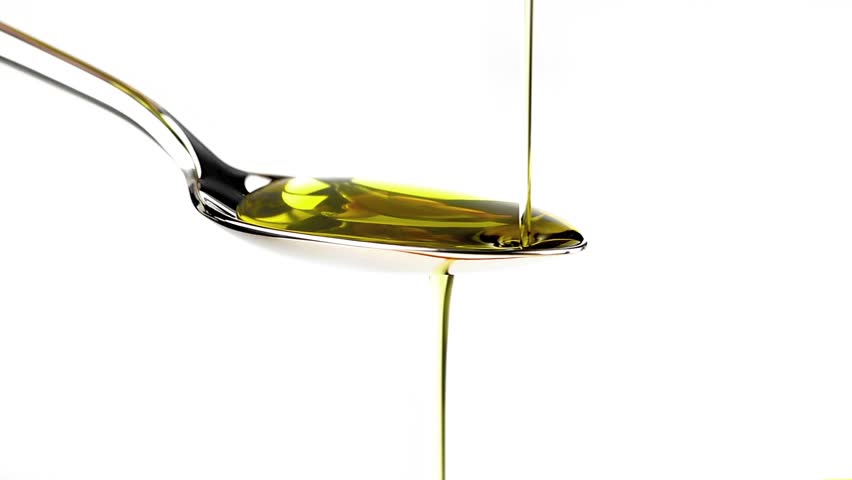Corn is a cereal cultivated plant. It already follows from this that it is rich in protein and vitamins of group B. Corn, now known to everyone, is considered the oldest cereal that was eaten several thousand years ago by the outdated generations of modern Mexico.

Corn is known as an ancient bread plant, spreading third place in the world after wheat and rice.
Neither children nor adults can manage without corn, because it gives not only a feeling of pleasant satiety, but also nourishes the body with its most valuable properties, many of which remain when the corn oil is pressed. What is corn oil, the benefits and harms, how to take it - we will consider everything in our article.
What is the raw material for corn oil
Oil is crushed from the embryos of corn seeds, which look like seed kernels and make up only 10% of the weight of the seed itself. The main part of the grain is powdery-protein substance - endosperm, which is closed in a bright color shell. It is this substance that is ideal for flour, glucose, molasses, starch, popcorn, whole corn grains are delicious in salads, boiled, canned, in the form of corn sticks and cereal, and alcohol is also made from corn and beer is brewed.

But so that the flour from corn is not bitter, the grains are separated from the nucleoli, the embryos, from which corn oil is crushed. The embryos are filled with fats - about 80%, minerals - 74% and about 20% protein. In the production of popular products from corn, it is these fatty oil compounds that are oxidized and hydrolyzed, which leads to a strong deterioration in taste and quality.
Embryos are separated from the grain by wet and dry methods. These are complex processes, as a result of which it is already possible to start production of the oil itself.
Wet separation of corn germ from grain
In order to isolate the germ from the corn kernel, the previously only method was used: corn was soaked and processed hydrothermally so that the grain shell was saturated with maximum moisture. Then the grain passed through a sieve and crushed. But the purity of the treatment was very low - the embryos fell into the waste and cereals. Therefore, they developed a new method by tearing grain from the inside and passing the resulting mass through drying, sorting and cleaning devices. This method has improved the quality of the resulting cereals with a minimum content of seeds in it.
After a similar isolation of the embryos from the bulk, the endosperm, which is separated in large parts, produce corn sticks and flakes. Heavy particles of endosperm go to the production of cereals.
Dry separation of corn germ from grain
In this method, the grain is dried dry and the embryos, endosperm and the shell that goes to the bran are separated on screen devices. The result of this method is corn grits, flour and feed product. But, unfortunately, none of the technologies gives 100% purified seeds. And the question of improving the separation of embryos from the endosperm of corn is still relevant, because the higher the percentage of purity of the embryos, the higher the physiological value of the oil that is obtained from them.
What kind of oil is obtained from corn?

Oil obtained from the germ of corn is divided into several types, depending on the method of its selection.
- Unrefined.
- Refined non-deodorized.
- Refined deodorized brand D - for the manufacture of a children's diet.
- Refined deodorized brand P - for a wide distribution network and catering enterprises.
Corn oil production methods
There are two main methods for producing oil - press and extraction.
Extraction and extrusion through a press - oil pressed in a cold way is more useful, since it contains all the trace elements useful in the seeds, which are very numerous. But it is opaque and has a precipitate, so it must be cleaned, filtered, it is organic and most useful. Hot pressed oil, in which the seeds are preheated, has a dark color.
Oil that is squeezed out of the embryos of the wet isolation method is suitable for cooking only after refining and deodorization.
The oil obtained as a result of cold pressing from dry-extracted corn kernels does not require refining and deodorization, it has a light golden color, a pleasant smell and a delicate taste characteristic of young "milk" corn. It is this kind of corn oil that is valuable in a large number of unsaturated fatty acids that have a regulatory effect on lipid metabolism and cholesterol, preventing the deposition of its excess on the walls of blood vessels.
Unrefined corn oil - benefits and harms
Unrefined corn oil has a higher status than refined corn, due to the abundance of its composition of essential and non-essential fatty acids, fat-soluble vitamins, including biologically active components that effectively regulate the body's metabolic processes.
Heating unrefined oil higher than 200 ° C leads to the destruction of the most valuable vitamin A and phosphatides, consisting of phosphoric acid and useful fatty acids, to some loss of polyunsaturated fatty acids. But the most unpleasant thing is the harm of corn oil - heating leads to the decomposition of fat, resulting in the formation of a number of liquid and gaseous substances that irritate the mucous membrane of the gastrointestinal tract and have a carcinogenic effect.

Unrefined oil requires special storage conditions to avoid the formation of a bitter taste, clouding of color and the appearance of an unpleasant odor. Such oil should be stored in a glass bowl, in a dark, cool place, without direct sunlight, so that corn oil is beneficial and not harmful.
Than richly refined corn oil
Oil refining - purification from mechanical impurities, discoloration, oil neutralization, as a result of which the oil remains practically odorless and is intended for wide network sales. The color of refined corn oil is very similar to refined sunflower oil, as well as sunflower, it does not form when frying smoke and foaming.
The benefits and harms of refined corn oil are not much different from those of unrefined oil. In the process of refining, the oil acquires a light yellowish tint and a slightly pronounced smell. There are also positive consequences of refining, due to which residual pesticides and toxic impurities are removed from the oil. But at the same time, most of the microelements and nutrients necessary for the body are removed. That is why the most enriched with useful substances is unrefined corn oil.

Refined oil, unlike unrefined oil, does not lose its properties when exposed to light and heat, it can be stored in plastic containers for a long time, and neither its characteristics nor its quality will be affected.
Refined deodorized corn oil. Benefit and harm
This type of oil is characterized by the fact that it has passed all stages of refining and deodorization. Refined deodorized no longer has such pronounced hypocholesterolemic properties. That is what is his biggest flaw.
Refined deodorized corn oil, which is obtained by traditional technology, does not have such a bright physiological effect on the body as just refined corn, including the absence of hypocholesterolemic properties. This is explained by the specifics of the technology that uses hard modes, which lead to the destruction of active beneficial substances - sterols, carotenoids, tocopherols with the loss of their natural biologically active properties.
Slimming corn oil
Corn oil is saturated with phospholipids - biologically active components that enter the structure of cell membranes and regulate brain function. Unrefined corn oil is useful in the daily diet for people suffering from obesity, liver disease, atherosclerosis, diabetes mellitus, patients with lipid metabolism disorders or a combination of disorders of carbohydrate and lipid metabolism.
The benefits and harms of corn oil for weight loss should be considered in each case separately, in consultation with a specialist. But there are general recommendations that can be applied by people who want to lose weight, for which corn oil is ideal. Particularly unrefined, since it is corn oil that has not passed refining, which is beneficial and not harmful, contains a maximum of healthy substances for the whole body.

Of course, corn oil is not a panacea for weight loss. It is advisable to add it to salads, dough, eat a small amount in the morning on an empty stomach. The benefits, as well as the harm of corn oil to the body, are undeniable. Corn oil has a laxative effect, gently stimulating intestinal motility, which undoubtedly has a beneficial effect on the general condition of the body.
The healing properties of corn oil
- Corn oil is recognized as the most hypoallergenic, so it is completely safe for children of any age.
- The oil is saturated with vitamin E two times more than sunflower and even olive, thanks to which the endocrine system is supported normally - the work of the sex glands, pituitary, adrenal glands, thyroid gland.
- Corn oil prevents muscle fatigue and weakness.
- Oil protects the genetic center of cells from mutational processes that occur when exposed to ionizing radiation and chemicals.
- The benefits and harms of corn oil, rich in polyunsaturated fatty acids that our body does not synthesize itself, so we need to get them every day, while the oil strengthens the immune system and removes excess cholesterol.
- It is saturated with B vitamins, activating the brain with vitamin E, which is a “progeny-bearing”, vitamin K, which normalizes blood coagulation, and choline, which removes fat from the liver.
- There is a lot of talk about the benefits and harms of corn oil, one thing to remember is not to consume it in large quantities, especially unrefined. Also, with caution, it must be used by people with gallstone disease and with thrombophlebitis.

Reviews of the benefits and harms of corn oil are the most encouraging. After all, there are no serious contraindications to the use of corn oil, except for an allergy to corn. The only thing experts warn about is that the normal daily dose of corn oil is 30 grams, that is, two tablespoons, not more.